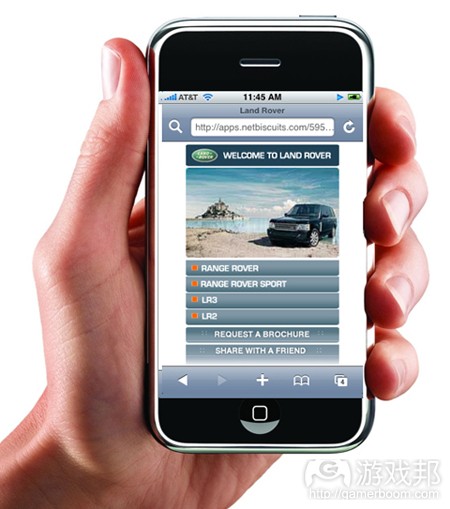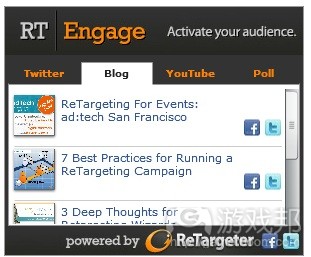手机广告需提升目标定位能力和创造性
作者:Samir Soriano
手机广告效果并不是很好。或许将来它们会发挥出应有的作用,但现在这种情况还没有出现。这让我感到很好奇,为何这么多广告商愿意花重金在此平台上投放广告。
手机广告设计不美观且很恼人,通常与最终用户之间并无关联。美国大学生中逾40%的人表示他们很讨厌手机广告,而声称关注手机广告的手机用户比例不足2%。YouGive民意调查显示只有14%的人曾经点击过手机广告,Deloitte报告数据表明忽视手机广告的英国手机用户约占88%。
仅仅在十年前,条幅广告的地位与现在的手机广告相同,用户觉得讨厌而且最终效果也不好。然而,现在此类广告已经在设计和用户定位方向有所改善。近期的实例研究已证实此说法属实。精确定位且设计精巧的广告能够增加品牌的曝光度和用户的购买意向。2010年,显示广告盈利总计99亿美元,与2009年的80亿美元相比上扬24%。谷歌Neal Mohan在Interactive Advertising Bureau(游戏邦注:下文简称“IAB”)MIXX会议上预测,2015年显示广告将成为价值500亿美元的产业。尽管手机广告被人大肆鼓吹宣传,但显示广告真正推动了盈利和创新。
IAB和PricewaterhouseCoopers估计,2010年手机广告盈利为5.5-6.5亿美元。过去两年来,在手机上做广告的公司数增加了一倍多。尽管过去数年来手机广告增长显著,但其为广告商带来盈利的能力却不及显示广告。
或许不久之后手机广告能够赶上,但要实现这个目标,手机广告还需要提高其目标定位和设计。
来自显示广告的经验1:目标定位
显示广告已经趋近成熟,刚开始它采用的是实时投标的方法,也就是让营销人员和媒体购买者以能够接受的价格购买广告栏位。现在,低预算在线营销人员可以选择将广告投放在某些流量较高的品牌相关网站,使品牌认知度和销售量得以增长。基于cookie的再定位方法可以让广告商使用cookie来根据浏览行为定位受众,提升显示广告的整体效果。将此方法与其他的背景、地域和人口定位方法相结合,再定位便可以让广告商使在线广告发挥最大效能。尽管显示广告的定位并不完美,但确实存在很大的有时,也已经证实能够产生价值。
虽然手机广告也有许多相似的定位方法,但它极为缺乏行为数据。广告商可以关注投放受众所偏爱的应用。但是,手机领域中基于cookie的再定位方法依然很不成熟,因为手机分裂性而无法在所有平台中发挥其效能。iOS的Safari浏览器是在美国占23.5%市场份额的手机浏览器,它无法默认使用第三方cookie,这使得手机再定位极为困难。
然而,有些公司正在努力加强改善手机广告的定位能力。
位于纽约的TapAd正努力创造出有效的手机再定位解决方案。尽管该公司的服务能在Android操作系统中使用,该公司也控制了此系统中的绝大多数手机浏览器,但它仍然需要解决iOS系统上的问题,因为目前苹果手机数量众多,而且该系统的平板电脑占据多数市场份额。手机广告定位需要提高与最终用户的相关性,这一点应该可以实现,但是仍然需要大量革新。
另一家位于纽约的公司AppNexus提供实时广告平台,允许企业围绕其显示广告交互API购买、销售和构建技术。近期,公司也增加了应用内置手机类别。尽管现在这或许不能视为开拓性的举措,但采取此方法可以使企业在AppNexus平台之上构建定位能力或将其手机数据和广告整合至AppNexus平台中。而且,我们可以想象到,AppNexus正开始构建其自己的手机专属定位服务。
来自显示广告的经验2:创造性
你还记得1999年的条幅广告的样子吗?正如下图所示:
过去15年来,条幅广告的发展过程确实非同寻常。Javascript和Flash的出现以及整体互联网带宽的提升使得条幅广告从恼人的低分辨率.gif文件转变成迷你网页。这些广告可接入性较强,可以很容易地植入发布商的内容,用户点击率也更高。结合有效的定位措施和终端用户关联性,显示广告不仅找到了新方法,不仅能够吸引用户点击广告,而且还能够定位到准确的用户。
相比之下,今日的应用内置手机广告提供的帮助并没有如此之大,而且还影响到终端用户的应用使用体验。这些广告看起来很刺眼,半数以上是无意间点到的。手机带宽还无法处理高分辨率图片,手机屏幕也没有足够大的广告展示空间。
ReTargeter广告图片等显示广告与浏览器窗口很相配。它们包含多处吸引点和社交分享功能,提升用户整体品牌体验的价值。而应用内置广告占据了大块屏幕实用面积,这意味着用户很容易无意间就点到广告。比如,广告赞助版本的《愤怒的小鸟》中经常发生如下事情:广告很经常在玩游戏的过程中弹出,使得用户的游戏流程受到破坏。从广告商方面来考虑,这些策略性且用户关联性通常较小的广告最终会弱化品牌的价值。
正如某些公司正努力改善手机广告定位那样,也有些公司正致力于提升手机广告的创造性以及传播方式。
位于旧金山的Flite就是家此类公司,其平台允许广告商创造互动显示广告和综合性手机小站点。而该平台真正的亮点在于,让其显示广告将手机小站点推向用户的手机。像此类的创新之举的前进方向是正确的,但是我们目前还只能看到这种整合各种本地功能的广告网络。
创新之举不只属于Tapad、Flite和AppNexus之类的小公司,谷歌也在努力将手机广告往正确的方向发展。谷歌表示,1/5的零售搜索提问是在手机上发出的,而且多数此类提问都与用户所处的地域有关。正因为此,谷歌创造了个免费且简单的手机页面创建工具,吸引各地的小店来使用。尽管手机页面在技术上根本算不上具有“创造性”,但它们确实传达这广告目标。手机搜索用户经常通过搜索来寻找当地的商店或餐馆,但许多站点在手机浏览器上显示得并不好。使用这个工具的公司可以提升其手机访问用户的便利性,但我想这种手机页面的效能还未被充分发掘。
手机广告的未来
对于今天的产业来说,手机广告依然不突出,或许再过四年时间它能变得更加有效。现在,手机广告的境况似乎与1999年的显示广告类似。自那时起,显示广告突飞猛进。定位能力和创造性设计(游戏邦注:部分原因在于硬件的提升)都得到了极大的改善,显示广告慢慢演化成与用户有更多关联性并令其感兴趣的东西。我预测手机带宽的增加、手机浏览器标准的同意以及手机广告创造性的提升,能够使已经有所增长的手机广告市场更上一个台阶,但这需要一定的时间。(本文为游戏邦/gamerboom.com编译,如需转载请联系:游戏邦)
Mobile advertising: It’s overrated
Samir Soriano
Mobile ads aren’t effective. They could be, but they’re not yet, which makes me wonder why so many advertisers spend so much money advertising on this platform.
Mobile ads are annoying, ugly and often irrelevant to the end user. Over 40% of college students in the US said they found mobile ads to be annoying, while less than 2% of mobile consumers said they pay attention to targeted expandable mobile ads. A poll by YouGive found that only 14% of people ever click on mobile ads, and a report from Deloitte shows that about 88% of UK mobile phone owners ignore mobile ads.
Just a decade ago banner ads were seen in the same light: ugly, annoying, and ultimately ineffective. More recently, however, display ads have made improvements in their designs and the way they’re targeted. Recent case studies have proven this. Smartly targeted and well-designed campaigns can work to increase brand visibility and purchase intent. In 2010, display saw revenues totaling $9.9 billion, up 24% from $8.0 billion in 2009. Google’s Neal Mohan made a prediction at the Interactive Advertising Bureau (IAB)’s MIXX conference that display advertising will become a $50 billion industry by 2015. Mobile may be receiving all the hype, but display is what’s actually driving the revenue and innovation.
IAB and PricewaterhouseCoopers estimated mobile ad revenues to be $550 – $650 million in 2010, and the number of companies advertising on mobile has more than doubled in the past two years. While mobile advertising has seen explosive growth over the past few years, its ability to add value to advertisers is nowhere near that of display advertising’s.
It will eventually reach display’s level — probably soon — but to get there, there is a lot it has to learn in terms of targeting and design.
Learning from Display: Targeting
Display advertising has seen a huge maturation since the inception of real-time bidding. It has allowed marketers and media buyers to advertise across a large amount of inventory at an affordable volume. Today, low budgeted online marketers can target their ads behaviorally and contextually across some of the most visited and relevant sites, and witness a growth in brand recognition and sales. Cookie-based retargeting methods, which allow advertisers to use cookies to target audiences based on their browsing behavior, have really driven improvements in the overall effectiveness of display advertising. When combined with additional contextual, geographical, and/or demographical targeting layers, retargeting gives advertisers access to some of the most effective online advertising capabilities available. While display targeting isn’t perfect, it has definitely made huge advances, and has been proven to add value.
While mobile advertising has a lot of similar targeting options, it is heavily lacking on behavioral data. Your impressions can be focused on apps that are more appropriate for your demographic and geographic audience. However, cookie-based retargeting methods in the mobile space are still very new and don’t work across all platforms due to mobile’s fragmentation. iOS Safari browsers, which consist of 23.5% of mobile browsing in the US, actually disable third-party cookies by default, making mobile retargeting a tough feat to accomplish.
However, some companies out there are working hard to help advance mobile’s targeting capabilities.
New York-based TapAd is working hard toward creating an effective mobile retargeting solution. While its service works across Android OS, which controls the majority of mobile browsing, it still needs to tackle the iOS behemoth, which has a very strong mobile presence, as well as a massive majority share of tablet browsing. Mobile ad targeting needs to become more relevant to the end-user – its capabilities will get there, but there is still a bit of evolution required.
Another New York-based company, AppNexus, offers a real-time advertising platform that allows companies to buy, sell, and build technologies around its display inventory exchange API. It has also recently added in-app mobile inventory to its arsenal. While this may not seem groundbreaking at the moment, taking this step allows companies to build targeting capabilities over AppNexus’ inventory or integrate their own mobile data and inventory into AppNexus. Additionally, it isn’t too far fetched to think that AppNexus is starting to build its own mobile-exclusive targeting capabilities.
Learning from Display: Creative
Do you remember what banner ads looked like in 1999? Here’s a reminder:
The progression of banner creative over the past 15 years is truly remarkable. New efficiencies in Javascript, Flash, and overall internet bandwidth have advanced banner ads from annoying low-res flashing .gif files to something more along the lines of mini-websites. These ads are easily accessible by being embedded alongside publisher content that viewers have actively navigated to. Combined with the effective targeting and end-user relevancy that display advertising offers, display ads are finding new ways to not only be clicked on, but to be engaged with by the right people.
By contrast, today’s in-app mobile ads aren’t helpful and remove a lot of value from the end-user’s app experience. These ads are obtrusive, and half of them are clicked by accident. Mobile bandwidth can’t handle high res images just yet, and mobile screens aren’t big enough to show ads that aren’t obtrusive.
Display ads similar to the ReTargeter ad pictured fit nicely within browser windows. They can contain multiple points of engagement and social sharing capabilities, which add a lot of value to the viewer’s overall brand experience. Conversely, in-app ads take up a huge chunk of real estate, which means they’re easily tapped accidentally. The ad-supported version of Angry Birds, for example, is notorious for this: Ads tend to pop up in the middle of gameplay, ruining the flow of the game for the user. On the advertiser’s side, these static and often irrelevant ads ultimately diminish the value of the brand.
Just as some companies are striving to improve mobile targeting, other companies are redefining mobile creative and how it is delivered.
San Francisco-based Flite is one such company. Its platform allows advertisers to create interactive display ads and comprehensive mobile mini-sites. Where the platform really shines is in having its display ads push the mobile mini site onto a consumer’s phone. Innovations like this are a step in the right direction, but we have yet to see ad networks integrate any sort of native display-to-mobile functionality.
Innovation isn’t exclusive to smaller companies like Tapad, Flite, and AppNexus. Google has been working to help move mobile advertising in the right direction as well. Google says that one in five search queries in retail are on mobile phones, and that most of these queries are in reference to local availability. Because of this, Google has created a free and simple mobile landing-page creation tool, targeting local small businesses. While mobile landing pages aren’t technically “creatives,” they do serve a similar advertising purpose. Mobile search users far too often end up on a local store or restaurant’s site via search, but many sites aren’t optimized for mobile browsers. Companies that use this tool will help keep their mobile visitors from bouncing too quickly, but I think that the full power of a mobile landing page has yet to be discovered.
What’s next for mobile?
For businesses today, mobile should take a back seat. It has another four years before it’s really effective. Right now, it seems that mobile advertising is still where display advertising was in 1999. Display ads have seen a lot of advances since then. With vast improvements in targeting capabilities and creative design (augmented partly by hardware improvements), display has slowly evolved into something that’s relevant and interesting to consumers. It will take some time, but I foresee increased mobile bandwidth, more unified mobile browsing standards, and a redefined definition of mobile “creative” will all help fuel the effectiveness of the already growing mobile advertising market. I can’t wait to look back to this article four years from now. (Source: Venture Beat)
下一篇:游戏剧情设计小技巧之台词禁忌篇











































 闽公网安备35020302001549号
闽公网安备35020302001549号